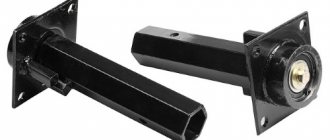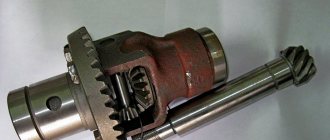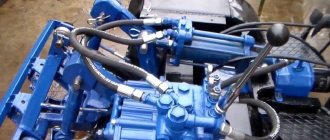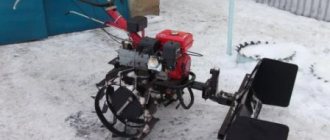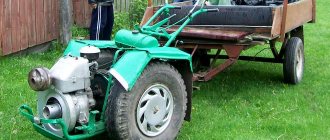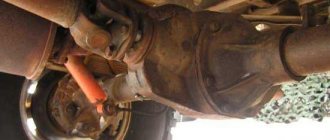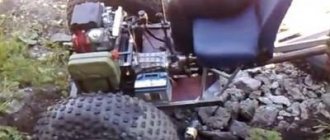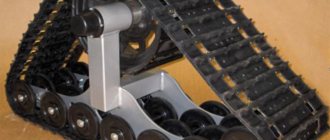Options for power distribution mechanisms
Structurally, the simplest way to solve the problem arising from the rigid connection of the wheels is to use overrunning clutches, which allow the wheel to rotate faster than the axle driving it.
Overrunning clutches
This mechanism is well known in all its variations: both with a ratcheting mechanism (bicycle wheel hub) and with wedging rollers (electric starter bendix).
Overrunning clutches are also used in the power drive of a number of cars with plug-in axles. However, this solution has a characteristic feature: when cornering, the overrunning clutch is disconnected on the wheel running along the outer radius, as it tends to rotate faster than the drive shaft.
To make it easier to enter a turn, on the contrary, most of the torque should be transmitted to it.
This problem is solved in the classic gear differential , which distributes power in inverse proportion to the rotational resistance of the wheels.
But it is also noticeably more difficult to produce, and also requires forced full or partial blocking on off-road conditions, since otherwise it redistributes all the power to the slipping wheel.
The need for this constructive mechanism
Before considering the process of making a differential for a walk-behind tractor with your own hands, you need to understand the need for this device. Let's consider the main points that apply to these parts of the power unit:
- first of all, it should be noted that this particular device is designed to obtain torque, which is transmitted from another power plant present on special equipment;
- It should also be understood that the differential on a walk-behind tractor, made with your own hands or at the manufacturer’s factory, is designed to transmit torque to the rotating axles;
- additionally, this mechanism is a constructive mechanism for distributing power, which is produced by the power plant of special equipment, and is subsequently transmitted to the main axis of the vehicle;
- it is important to take into account the fact that due to the differential mechanism, an effect is achieved that allows the mechanism for soil cultivation to freely enter turns and turn around;
- the use of overrunning mechanical components helps prevent slipping of one wheel, which can occur due to the uniform transmission of torque to one side.
Based on this, we can conclude that this structural mechanism on special equipment is extremely important, which significantly simplifies the procedure for cultivating the land, since without these mechanisms you have to manually deploy a heavy power plant, which not everyone can do.
Important! Another characteristic feature of this mechanical component is the ability to create inverse proportional traction, which makes it possible to significantly slow down one of the sides during sharp turns or completely supplement the wheel with reverse rotation, as a result of which the maneuver is performed much easier and faster.
Need for differential
Many works performed with a walk-behind tractor (for example, cultivation) require its linear movement . In this case, a rigid drive on both wheels works great, significantly reducing the cost and simplifying the walk-behind tractor.
If frequent sharp turns are necessary, a walk-behind tractor of this type will require significant physical effort - one of the wheels will be braked by lugs, and the walk-behind tractor will have to tilt, hanging the outer wheel in the air.
This is especially difficult if the walk-behind tractor has a wide track and is quite heavy.
conclusions
The differential for a walk-behind tractor is an irreplaceable component that allows you to reduce the physical stress on a person that is experienced when the vehicle enters a turn. This device is also responsible for the uniform and proportional distribution of torque on the axle, which allows you to control such a vehicle when cultivating the soil.
If the original parts do not provide the required effect, then the owner of the equipment can independently manufacture the device to suit his requirements, and then install it on the walk-behind tractor and operate the special equipment with greater comfort.
How to make a homemade differential for a walk-behind tractor with your own hands - drawings
How to make a differential for a walk-behind tractor with your own hands? As a rule, the operation of a walk-behind tractor does not require long-term rotation of the wheel relative to the drive axis.
Due to this, often called “semi-differential” schemes are common, which provide the ability to freely rotate the wheel relative to the axis at a certain angle.
For more information about the “semi-differential”, watch the video:
The simplest mechanism in this case looks like a bushing with a transverse slot attached to the axis of the walk-behind tractor. A short axle is inserted inside this bushing, secured from falling out by a bolt wrapped into its body through a slot, and the wheel is attached directly to the axle.
In this case, when the walk-behind tractor moves, the drive axle rotates the bushing freely until the rear edge of the slot rests against the bolt, and then transmits torque to the axle through it.
Soil cultivation is one of the main agrotechnical activities, which is a mandatory part of the annual soil cultivation regime. By clicking on the link, you will get acquainted with the convenient and practical Loplosh cultivator.
A snowmobile allows you to quickly and comfortably move through the snow from one point to another, while also carrying a passenger or some kind of cargo. Here is the lineup and prices of 2016 Yamaha snowmobiles.
The quality of the grown products, its productivity, and, ultimately, the return on financial and physical investments depend on the timely and high-quality use of special means when growing crops. Here you will learn how to make a sprayer with your own hands.
During a turn, the wheel, trying to overtake the drive, moves the bolt forward along the slot, breaking the transmission of torque, and the angle of easy rotation of the walk-behind tractor depends on the length of the slot.
Such extension cords are extremely simple and can be made by unskilled machine operators, and therefore are cheap and widespread. They are usually made with several additional holes, allowing you to vary the track width of the walk-behind tractor and rigidly connect the wheel to the drive axle if necessary.
Drawings of these homemade differentials are widely distributed on the Internet.
The disadvantage of the described design is the relatively small possible angle of free rotation of the wheel (no more than 240 degrees), since the transverse groove greatly reduces the overall strength of the mechanism, and high internal friction, especially when dirt inevitably gets inside the bushing.
Most often, extension cords with free movement are used on light walk-behind tractors, like the Niva.
The differential for walk-behind tractors Salyut and the like Texas, Foreman, Viking, Forza, Sadko, Don, Huter, Profi, which have a relatively large mass, has a slightly more complex design, but also a larger free play angle - within 330 degrees.
This is ensured by the fact that engagement is carried out by protrusions on the drive axle extension and on a freely rotating hub equipped with ball bearings mounted on it. Accordingly, the hub can make almost a full rotation relative to the axis until it rests against the opposite edge of the protrusion.
It is much easier to deploy a walk-behind tractor with such differentials.
A number of designs allow the wheels to rotate freely relative to the axis and by more than one revolution. For example, the differential of the “Farmer” walk-behind tractor consists of two clutches controlled by levers on the steering wheel.
If necessary, the owner of the walk-behind tractor can disengage the desired clutch, allowing the corresponding wheel to rotate as long as desired.
Purpose of this element
Before you familiarize yourself in detail with the varieties, manufacturing options and mounting method, you need to consider why a differential is installed on a walk-behind tractor, namely:
- The main function of this device is to distribute power between the wheels of special equipment.
- At the moment of rotation of the wheel relative to the axis, this mechanism does not allow the element passing along a smaller radius to slip.
- A load is regularly placed on the differentials, provided that rotation of the wheels is created relative to the axis in a different projection (when cornering).
- The device allows you to process a relatively large mass (the load that appears when the direction of the axis changes).
General Tips
Let's start with the simplest option in the form of an axle extension with a transverse groove . It will be quite reliable even if made from affordable mild steel.
Axle extension
It is better to use a bolt connecting the components of the extension with an internal hexagon head and mill a groove with a width equal to its outer diameter.
In this case, firstly, there are no protruding parts capable of wrapping grass around itself, and secondly, a bolt tightened all the way will not become loose over time.
The gap between the bushing and the extension axle cannot be made too small , since if corrosion occurs they will become acidic to each other. It is highly advisable to place a grease fitting on the bushing for in-place lubrication of the structure.
The more complex rotary hub design can also be made from mild steel as it is easily welded.
Finishing of the bearing holes in the hub must be done after the flange and rotation angle limiter are welded due to the inevitable warping of the part during welding.
Making a differential for a walk-behind tractor yourself cannot be called a technically difficult task, and this is proven both by the experience of many owners of garden equipment and by the fact that common offers in online stores copy originally handicraft designs.
Self-production of a hub for a walk-behind tractor
As already mentioned, there are different options for the design of hubs for walk-behind tractors. To make the simplest version, you can use the following drawing:
The main thing to remember when making your own is to follow safety precautions and use high-quality materials for a longer service life of the part.
We also invite you to watch a detailed video that describes the intricacies of making a homemade hub for a walk-behind tractor:
We make wheels for a walk-behind tractor with our own hands
A walk-behind tractor is a technique that is familiar to most farmers. In fact, this is a mobile tractor that is used for plowing soil, planting plants or transporting goods. It is convenient in small summer cottages, where it is already difficult to do everything by hand, but a large tractor is not needed. If you are reading this article, then you either already have a walk-behind tractor or are planning to purchase one.
One of the most common questions from owners of this equipment is how to make wheels for a walk-behind tractor with your own hands? The thing is that in the standard configuration they wear out very quickly, and are also not suitable for all types of soils and terrain. Buying new ones is quite expensive, so you can resort to your own skills. In this article we will look at exactly how to do this.
Advantages and disadvantages
The main advantage of this method of solving the problem of turning wheels is the simplicity of the design. In addition, such a differential is universal, as it is suitable for almost all types of walk-behind tractors.
But the semi-differential also has its disadvantages. Here, first of all, you need to note the small angle of rotation that will be available after installing such a structure. This type of mechanism does not allow rotation of more than 240º. Many farmers note that the presence of a transverse groove makes the structure not very strong. If the load is significant, the axle may break. Therefore, those who decide to use their own made differentials for a walk-behind tractor should be prepared for the fact that the structure will periodically have to be repaired and remodeled.
Considering all the pros and cons, we can say that for those who are not too demanding of their walk-behind tractor and lightly load it with straight and rotary work, a semi-differential is perfect. For serious loads, it is worth looking for more durable structures.
Types of wheels
First you need to figure out what types of wheels for walk-behind tractors exist. Since the equipment is used in many farming processes, the equipment varies. This also applies to pneumatic wheels, because good results and ease of use also depend on the right components. It is important to note that ordinary car wheels from Oka, Niva or Moskvich cannot be installed on the walk-behind tractor. All of the options below are larger and heavier. It would be more correct to compare them with ATV kits, although they do not always have the appropriate size.
- Pneumatic. This option can be used for arable work and for removing roots from the soil. These are large wheels in appearance, with a diameter of 40 cm and a width of 20 cm. The tread pattern must be rough for the walk-behind tractor to work well on the soil. Often this option comes as standard and is famous for its wear resistance. However, if they become unusable, you should immediately look for a replacement.
- Traction. The popular name for these wheels is herringbone. All because of the pronounced pattern on their tires. This type is also universal and suitable for lug or standard transport solutions. For example, they are often used by snow blowers. Traction tires for walk-behind tractors are also reliable in everyday use.
- Solid cast (most often made of rubber). Solid castings are ideal for rocky ground. They allow the walk-behind tractor to move faster on such terrain and do not deteriorate after the first use. The downside is that they are really very heavy, so carrying them is not so easy. Such tires are suitable for MTZ series walk-behind tractors and diesel vehicles.
- Metal. The last variation is suitable for clay soil. The thing is that, unlike previous wheels, these have steel teeth. This, of course, makes the equipment heavier, but in soft ground they do their job perfectly. In another way, metal teeth are also called lugs.
As for general recommendations, when choosing what to put on your walk-behind tractor, pay attention to the front wheel. It is supportive and during use it absorbs the entire mechanism. This helps to extend the service life and improve the quality of work.
In general, this classification of pneumatic wheels is used not only for walk-behind tractors, but also for trailers or other tools from the same category. So you can safely use it, because to maintain the wear resistance of all equipment, the farmer’s assortment must include both a trailer and a walk-behind tractor.
Types and characteristics of hubs for walk-behind tractors
The hub for a walk-behind tractor is an important element of the design of an agricultural machine. Its presence, paired with an installed special attachment, significantly improves the quality of plowing the soil, hilling beds, planting potatoes, harvesting and other activities in the garden.
There are two types of hubs on sale.
Among them stands out:
- differential hub - this part is considered universal and can be mounted on all walk-behind tractors, regardless of their class and design features. Differential hubs are required for use on those walk-behind tractors whose factory equipment does not include a wheel unlocking mechanism, as well as for those models of equipment that cannot be freely deployed at the end of the cultivated bed. This walk-behind tractor wheel hub is equipped with bearings, which significantly increases the maneuverability of the unit:
- ordinary hub - a part of this type has a simpler design, but is less efficient in use. It only slightly improves the maneuverability of the walk-behind tractor, so every year it is in less and less demand among farmers.
Differential hubs, or semi differentials as they are also called, consist of one or a pair of bearings, as well as retainers. When using such a part, in order to turn the walk-behind tractor, it is necessary to disconnect the lock from the corresponding latch.
Depending on their diameter and shape, differential hubs for walk-behind tractors can be of the following types:
- round hub;
- sliding part;
- hexagonal hub - can have a diameter of 24 or 32 mm.
This kind of classification of semi-differentials allows the farmer to select the part that is optimally suited for installation on his walk-behind tractor and will bring maximum benefit when used.
How to make wheels with your own hands
Having understood the types of tires, you should learn how to make the same ones, but homemade ones. The first thing to consider is that in any case you will not be able to make wheels for a walk-behind tractor from scratch. You will need a base - old pneumatic wheels from a car, for example, from Oka or Niva. In this matter, everything depends on your choice or availability of suitable material. And by the way, farmers do not recommend buying a new set of tires for conversion, since they are not cheap and as a result, you will not be able to save a decent amount by doing the rest of the work yourself.
The second thing, without which nothing will work, is that before the process begins, you need to prepare drawings. This issue must be handled responsibly and the drawings must satisfy the requirements based on the materials available.
Often paired wheels are made, where additional weighting material can be placed inside. Let's start with this option. The twin option is a quick and effective wheel conversion that is affordable to many. You will need 4 wheels with a good stainless steel base (by the way, the masters have tires from Moskvich). It is also necessary to have iron plates with you. The process itself is carried out in several steps.
- The rubber tire is removed from the base.
- Several iron plates, up to 5 cm wide, must be welded to the rim on which the tire is placed. Usually, the plates are formed into a square, which is welded to one of the sides of the rim.
- Next, the rim from the second wheel is welded to this square. So you connect two rims together using plates and welding.
- At the last stage, the rubber is put back on the rims.
That's it, you have received the kit you need. As you can see, their main advantage is their large width. Thanks to this, they look less like wheels from a car, and more like an option for a walk-behind tractor.
The second option for strengthening pneumatic wheels is to increase their wear resistance using additional materials. In this way, you can remake the wheels of a vehicle such as a motorcycle or ATV. In general, you will need larger tires than for a regular car. And to increase rigidity, large chains may be suitable.
Let's move on to the process itself: chains need to be welded to the pneumatic wheels. You can try connecting them with rubber or an iron rim. Next, you need to make notches on them so that they imitate lugs. The result should look like store-bought metal wheels.
You will have to tinker with this method so that the chains hold tightly and do not fly off during work. Locking the chains with the rim will help here, which can be done using steel fasteners and hooks.
An additional element that is often missing for the convenience of working with a walk-behind tractor is an unlocker, sometimes called a differential. Since the instrument itself is heavy, it is often difficult to control it, namely, to turn it in different directions. In this case, an unlocker comes to the rescue - a special device that is attached to the wheels and increases their maneuverability in difficult areas.
The unlocking tool is installed to the output shafts of your walk-behind tractor using bolts. During operation, it reduces the turning radius of the entire machine and increases the track width. If you use a mini-tractor on a regular basis, then this thing is simply irreplaceable. You can make an unlocker yourself based on bearings, but in fact, the game is not worth the candle. You can find a wide variety of them on the market, and the unlockers are inexpensive. The most important thing is to find a specialist who can recommend a good product.
What homemade products for a walk-behind tractor you can make with your own hands
Homemade products for walk-behind tractors are invented and made by almost all owners of this equipment. The purpose of these actions is to expand the functionality of the unit with minimal financial investment. In the basic configuration, the motor cultivator has extremely limited capabilities. Installing various options on it can turn a small machine into a full-fledged mini-tractor. Often, homemade devices are in no way inferior to factory-made analogues. In order to improve a walk-behind tractor with your own hands, a set of tools that are available in every workshop of a country house or cottage is sufficient. The materials you need can be found at a junkyard, shed, or scrap metal collection point.
Improvement of the chassis
The first thing users of a walk-behind tractor think about is how to make a cart with a seat for it. Using equipment in normal mode using levers requires the application of great physical effort. However, the use of a trailer reduces the stability of the vehicle. This problem can be eliminated by extending the wheelbase. This is done using extensions that are attached to the axle shaft with pins or bolts. Having solved the stability problem, the operator is faced with another issue: the unit is poorly controlled. The differential for the walk-behind tractor helps to give it good maneuverability. This device is made by analogy with components of passenger cars. Homemade unlockers for walk-behind tractors are made using ordinary household tools - an angle grinder, welding and a sharpening machine.
The low weight of the walk-behind tractor causes poor traction between the wheels and the ground. Slipping is a common occurrence when lifting virgin soil, working on wet ground or driving in snow. To avoid slipping, weights are attached to walk-behind tractors.
These devices are divided into the following categories:
- Wheeled. They are discs that are mounted on wheels or hubs. Disks are made monolithic from metal, concrete or hollow, filled with sand. The weight of wheel weights can be 30-70 kg.
- External. Made from any heavy material (steel, lead, concrete). Attached to the body using hooks or bolts. Some craftsmen weld a frame from a corner to the body. Sandbags, bricks, scrap metal and other heavy objects are placed in it.
You can improve the cross-country ability of a walk-behind tractor by installing lugs. The easiest way to make lugs is to make a rim from a strip of metal and weld blades onto it. The rim diameter should be larger than the rims and smaller than that of the tires. The rim is installed with flat tires. After the lug is installed, the wheel is inflated.
You can improve the transmission by installing a homemade variator on the engine. The system of belts and discs will allow you to smoothly change the speed of the unit, without jerking or vibration.
Reducing noise from the unit
Even the most modern and expensive motor cultivators make a lot of noise during operation, especially at high speeds. This factor greatly tires the operator and can serve as a reason for deterioration of relations with neighbors. A homemade muffler will help solve the problem. This is a task that can be accomplished by any craftsman with basic skills in handling iron.
In order to make a muffler for a walk-behind tractor with your own hands, you will need the following tools and materials:
- roulette;
- welding machine;
- Bulgarian;
- electric drill;
- hammer;
- aluminum clamp;
- stainless steel 2 mm thick;
- metal shavings.
Having collected everything you need, you can begin to improve the exhaust system.
This is done in the following sequence:
- Make 2 oval pipes from stainless steel. The diameter of the pipes should differ by 1-1.5 cm. The pipe joints should be fastened using a welding machine.
- In a pipe of smaller diameter, make a maximum number of holes with a diameter of 8 mm. Wrap it with metal shavings. Wrap the shavings with steel wire.
- Insert the smaller pipe into the larger one. Fix them in the desired position using steel rods and welding.
- Attach the muffler to the exhaust pipe and secure with a clamp.
The noise level after such an improvement will decrease several times. The service life of a homemade muffler will be at least 5 years. So, being content with little, you can significantly improve the conditions for carrying out agricultural and other work using a walk-behind tractor.
Blade for walk-behind tractor
The blade is a necessary device, which is needed at any time of the year. The front blade is used to clear snow, plan terrain, dig holes and move bulk materials. Such equipment for the Neva walk-behind tractor is of good quality, but not everyone can afford it. Do-it-yourself dumps require minimal financial investment. By installing the front blade on the Neva walk-behind tractor, you can solve many household problems. If there are levers and hydraulics, a homemade shovel can also be used as a loader.
To make a blade you will need the following tools:
- roulette;
- welding machine;
- electric drill;
- Bulgarian;
- spanners;
- acrylic paint;
- barrel 200 l;
- reinforced rubber;
- sheet steel 5 mm;
- profile pipe 40x20 mm;
- paint and brush;
- bolts and ties.
Before making a blade, it is necessary to calculate the compliance of the power of the walk-behind tractor with the dimensions of the bucket. Excessive load leads to rapid wear of parts and mechanisms of the unit. Depending on the weight and power of the machine, shovels are made 60-100 cm wide and 20-30 cm high.
Do-it-yourself snow removal for a walk-behind tractor is made in the following sequence:
- Applying markings to the barrel, sawing it into 3 equal parts vertically. Cutting 1 piece into strips 5 cm wide.
- Fastening 2 workpieces using bitumen and rivets. Aligning the edges of the product. Reinforcement of the bucket with transverse racks.
- Fastening strips of tin along the edges of the shovel. This is done by welding or bolts.
- Drilling holes for bolts. Attaching a strip of rubber to the bottom of the bucket.
- Making a hitch for a shovel. It is made by welding a piece of pipe and a semicircle of sheet metal to the blade. Holes are made on the sector to adjust the angle of attack. A homemade snow removal device is attached to the bracket of the walk-behind tractor with an adapter made of a profile pipe.
The finished product needs to be cleaned and painted. All bolted connections must be lubricated regularly to prevent corrosion.
Digging equipment
Potato diggers of various types are very popular among farmers. These devices save people from hard manual labor, speeding up the harvesting process several times. The walk-behind tractor has a very simple design. It can be made from metal that remains after the construction and renovation of a house.
To work you will need:
- Bulgarian;
- welding machine;
- electric drill;
- heavy hammer;
- anvil;
- profile steel pipe 20x40 mm;
- reinforcement 12 mm;
- tin (preferably stainless);
- bayonet shovel without handle.
The attachment to the walk-behind tractor is made in a suspended or trailed (modular) design. The hanging tool only digs up the tubers, leaving them lying on the surface for subsequent manual harvesting. A modular potato digger not only extracts the crop from the ground, but also collects it in a mobile container on a chassis.
The manufacture of a digger is carried out in the following sequence:
- Drawing up a drawing. The width of the digger should be within 25-30 cm. The angle of attack of the tip is taken perpendicular to the coulter so that the tool does not bury itself in the ground.
- The reinforcement is cut into fragments of a given length. Using a hammer and anvil, they are given the required bend.
- A container for tubers is assembled from a profile pipe and tin. The chassis or skids are welded to the container frame. The runners are made from pipes, and the chassis is taken from an old stroller, cart or lawn mower.
- The holder and reinforcement bars are welded to the shovel. A drawbar is welded to the holder, which is fixed to the assembly container. Connections are made movable using bolts or hinges.
- Rust and weld marks are removed. The finished product is treated with an anti-corrosion agent and coated with paint.
Adjustment and adjustment of the digger is carried out using racks and steel ties.
Included with the digger, you can immediately make a disk hiller. This tool will be needed when planting tubers after they have been buried in a trench made by a plow. Hillers are made from old pot lids, profile pipes and bolts. A trolley is assembled from pipes and small wheels, onto which holders for lids are welded at a certain angle. After sharpening on a stone, the discs are mounted on holders.
Making a field sprayer
A homemade sprayer for a walk-behind tractor is necessary in cases where the area of cultivated crops exceeds 20 acres. Doing this type of work manually is very difficult and can take a whole day. Mechanization of this process will save a lot of time and effort.
To make a sprayer you will need:
- welding machine;
- Bulgarian;
- level;
- electric drill;
- soldering iron for polypropylene pipes;
- profile or round water pipes;
- plastic or steel barrel with a capacity of 80-100 l;
- wide pneumatic wheels;
- plastic pipes;
- rubber hose;
- injectors or nipples from wheel tubes.
Assembling a homemade sprayer is carried out in the following sequence:
- Making the frame. Its dimensions are adjusted to the size of the container. The chassis is attached to the frame. For good cross-country ability you need at least 4 wheels. In the absence of wheels, wide skids are made of aluminum.
- The container is installed and secured on the frame. For this purpose, spacers and ties are used. Holes are made in the tank for supplying high-pressure hoses. The tank neck is sealed.
- A bracket for the pump is being manufactured. A model is selected that operates from a power take-off shaft (belt drive) or from electricity (motoblock generator).
- The irrigation system is being assembled. A durable holder is made from steel profiles. Plastic pipes are attached to it using clamps or plastic ties. A valve is being installed to bleed off excess pressure and injectors.
- All parts are connected together, the quality of the fastenings and the tightness of the joints are checked. The tank is filled with water, the unit is tested in various modes, and final adjustments and settings are performed.
A self-made sprayer will fully justify the efforts invested in the first season. Thanks to this device, spraying and watering the garden will be done quickly and efficiently.
Tips for choosing a hub for a walk-behind tractor
On the open market you can always find a large selection of hubs designed for installation on various models of walk-behind tractors.
In order not to make a mistake when choosing a part, farmers should adhere to a number of certain rules:
- when ordering a hub for a walk-behind tractor, you should indicate the class and model of the agricultural implement;
- in most cases, when selling a walk-behind tractor, one set of hubs is included in its kit. In this case, when using attachments, there is no need to rearrange the hubs. This, in particular, applies to the lugs used on the walk-behind tractor. This feature will save a lot of time when working in the garden;
- If the walk-behind tractor is equipped with pneumatic wheels, then its delivery set will necessarily include hubs.
By adhering to these simple rules, every novice farmer will be able to choose a walk-behind tractor equipped with hubs or choose the right parts, separately from the agricultural machine.
Diagram of the “differential” device for a walk-behind tractor
To carry out an easy and quick turn of the walk-behind tractor at the end of the bed, it is necessary that one wheel is blocked and the second rotates. How to improve and make it easier to turn a walk-behind tractor? On a car, this function is performed by a differential. Installing a differential on a walk-behind tractor would be both expensive and technically difficult, so we came up with another solution. On a homemade walk-behind tractor, you can install one or two unlockable axle shafts or semi-differential wheel hubs , whichever device is more convenient for you to make. You can also make hubs with overrunning clutches , although this device is more complex and expensive to make with your own hands, but they can be used second-hand from various devices and mechanisms. This design of the wheel axle makes it possible to independently rotate one wheel of a homemade walk-behind tractor relative to the other. The layout diagram of a homemade walk-behind tractor with a manual axle axis lock shows: 1-motor of a homemade walk-behind tractor; 2- walk-behind tractor wheel with lugs; 3- manual axle shaft lock or unblockable axle shaft of a walk-behind tractor; 4-solid axle shaft of a homemade walk-behind tractor
Differentials, unlockers, overrunning clutches, etc.
In this topic, I invite my colleagues in motoblocks to share information and experience in making mephanisms and devices that make it easier to wrap and turn a moto. And I present for consideration the axle unlockers that I recently made.
Alvis wrote: recently made
Have you already tried it? that is, your device can even steer the MB if desired.? A lot of work has been done - how long have you been working on?
For my future MB I will install a rear axle from a LuAZ car, it has one drawback: the track cannot be changed, but it will have a lock and a differential.
ALVIS, as much as I have been watching you, I am amazed by your inexhaustible supply of ideas for modernizing your walk-behind tractor. Moreover, you turn them into reality. You can immediately see that a person who wants to work in comfort has chosen the right walk-behind tractor for himself and strives to reduce its shortcomings to zero. NMB owners have been waiting for this unlocker for a long time. Bravo.
Alvis
Good idea and quality production.
Talk nonsense carefully, trying not to spill it. Nonsense is good when it is complete!
student_ya wrote: Have you tried it yet? that is, your device can even steer the MB if desired.? A lot of work has been done - how long have you been working on? For my future MB I will install a rear axle from a LuAZ car, it has one drawback: the track cannot be changed, but it will have a lock and a differential.
It won’t unlock while moving, you have to stop the walk-behind tractor and then press the clutch handle. Unlocking the wheels also works like differentials; the wheels have free play by half a turn. About work: a month with breaks and the job is done
Your future motorcycle with locking and differential is a matter of business. and the track can be changed using extensions. Good luck in creating a new walk-behind tractor.
njuk wrote: ALVIS, as much as I have been watching you, I am amazed by your inexhaustible supply of ideas for modernizing your walk-behind tractor. Moreover, you turn them into reality. You can immediately see that a person who wants to work in comfort has chosen the right walk-behind tractor for himself and strives to reduce its shortcomings to zero.
njuk thank you for your kind words and I really want to work in comfort and not suffer.
njuk wrote: NMB owners have been waiting for this unlocker for a long time. Bravo.
This means it was ahead of the KADVI plant
Djuse wrote: Alvis Good idea and quality production.
Djuse Thank you, I tried
Unlockable half of a homemade walk-behind tractor
Open photo Unlockable half of a homemade walk-behind tractor in enlarged form. If this is a drawing or diagram of a device, you can download it to your computer by opening it in large size and using the “Save picture as” function. "(right mouse button). Please rate this material by highlighting the appropriate number of stars.
Most often, together with this material on the topic |
Rating of TOP 10 best models
| Place | Name | Price |
| TOP 5 best gasoline walk-behind tractors with power take-off shaft | ||
| 1 | PATRIOT Pobeda (440 10 7212) | 25 000 ₽ |
| 2 | PATRIOT Nevada 9 | 45 000 ₽ |
| 3 | CHAMPION BC1193 | 45 000 ₽ |
| 4 | PATRIOT Nevada | 47 000 ₽ |
| 5 | Tselina NMB-901 | 41 000 ₽ |
| TOP 5 best diesel walk-behind tractors with power take-off shaft | ||
| 1 | Weima WM1100BE (wheels 5x12) | 79 000 ₽ |
| 2 | PATRIOT Boston 9DE | 57 000 ₽ |
| 3 | Weima WM1100A (wheels 5x12) | 62 000 ₽ |
| 4 | CHAMPION DC1193E | 65 000 ₽ |
| 5 | Aurora SPACE-YARD 1350D | 82 000 ₽ |
